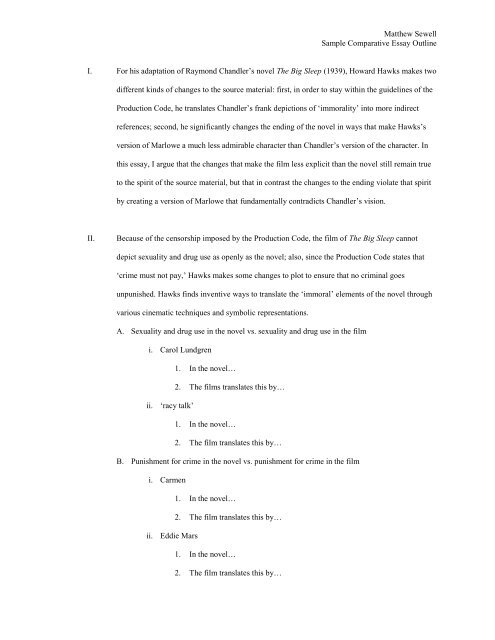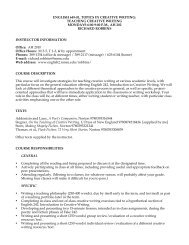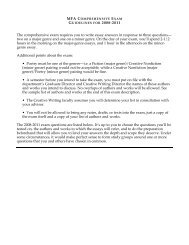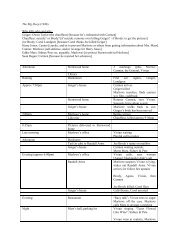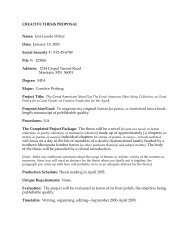Sample Comparative Essay Outline
Sample Comparative Essay Outline
Sample Comparative Essay Outline
Create successful ePaper yourself
Turn your PDF publications into a flip-book with our unique Google optimized e-Paper software.
Matthew Sewell<br />
<strong>Sample</strong> <strong>Comparative</strong> <strong>Essay</strong> <strong>Outline</strong><br />
I. For his adaptation of Raymond Chandler’s novel The Big Sleep (1939), Howard Hawks makes two<br />
different kinds of changes to the source material: first, in order to stay within the guidelines of the<br />
Production Code, he translates Chandler’s frank depictions of ‘immorality’ into more indirect<br />
references; second, he significantly changes the ending of the novel in ways that make Hawks’s<br />
version of Marlowe a much less admirable character than Chandler’s version of the character. In<br />
this essay, I argue that the changes that make the film less explicit than the novel still remain true<br />
to the spirit of the source material, but that in contrast the changes to the ending violate that spirit<br />
by creating a version of Marlowe that fundamentally contradicts Chandler’s vision.<br />
II.<br />
Because of the censorship imposed by the Production Code, the film of The Big Sleep cannot<br />
depict sexuality and drug use as openly as the novel; also, since the Production Code states that<br />
‘crime must not pay,’ Hawks makes some changes to plot to ensure that no criminal goes<br />
unpunished. Hawks finds inventive ways to translate the ‘immoral’ elements of the novel through<br />
various cinematic techniques and symbolic representations.<br />
A. Sexuality and drug use in the novel vs. sexuality and drug use in the film<br />
i. Carol Lundgren<br />
1. In the novel…<br />
2. The films translates this by…<br />
ii. ‘racy talk’<br />
1. In the novel…<br />
2. The film translates this by…<br />
B. Punishment for crime in the novel vs. punishment for crime in the film<br />
i. Carmen<br />
1. In the novel…<br />
2. The film translates this by…<br />
ii. Eddie Mars<br />
1. In the novel…<br />
2. The film translates this by…
III.<br />
Hawks’s changes to the ending, however, are not required by the Production Code or any other<br />
authority; instead, they arise from a fundamentally different vision of Marlowe’s character.<br />
Chandler’s version of Marlowe is principled and virtuous even to his own detriment; Hawks’s<br />
version of Marlowe abandons his principles in order to protect his love interest.<br />
A. Marlowe’s principles in the novel vs. Marlowe’s principles in the film<br />
i. Loyalty<br />
1. In the novel…<br />
2. In the film…<br />
ii. Honesty<br />
1. In the novel…<br />
2. In the film…<br />
B. The ending of the novel vs. the ending of the film<br />
i. Killing of Eddie Mars<br />
1. In the novel…<br />
2. In the film…<br />
ii. Relationship with Vivian<br />
1. In the novel…<br />
2. In the film…<br />
IV.<br />
I contend that Hawks successfully translates the novel’s representation of ‘immoral’ behavior<br />
while staying within the guidelines of the Production Code. Crucially, however, Hawks fails to<br />
translate the core of Marlowe’s character. The changes to the ending demonstrate that for Hawks,<br />
Marlowe is willing to abandon his principles if it suits his personal interest, whereas for Chandler<br />
such a decision would contradict a fundamental element of Marlowe’s character. Hawks’s film<br />
offers an interesting and provocative portrait of Marlowe, but this portrait does not accurately<br />
represent Chandler’s vision.


